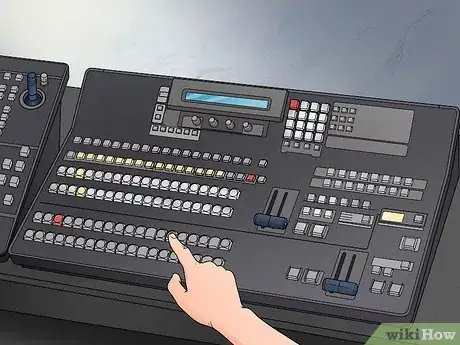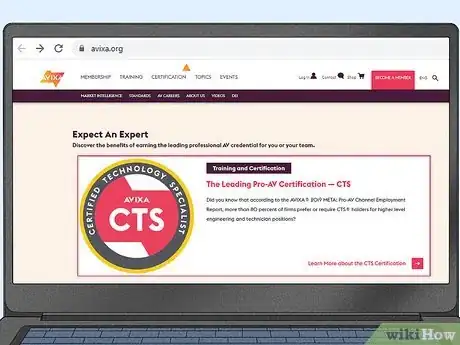wikiHow is a “wiki,” similar to Wikipedia, which means that many of our articles are co-written by multiple authors. To create this article, 12 people, some anonymous, worked to edit and improve it over time.
This article has been viewed 110,011 times.
Learn more...
Audio visual (AV) technicians provide presentation technology support to corporations, educational and government agencies, hotels and convention centers and other business and entertainment venues. Job responsibilities generally include the maintenance, setup and operation of multimedia equipment. Technicians also work at television and radio stations operating master control equipment, maintaining studio and news cameras and performing other general technical jobs in support of production.
Steps
-
1Familiarize yourself with a broad range of audio visual equipment.[1]
- You will need a wide general knowledge of audio, video and computer technology.
- Computer aptitude and familiarity with different operating systems and presentation programs such as PowerPoint and Keynote will be helpful in accommodating a variety of clients.
- Camera, videography and lighting skills will also help you to advance in the field.
-
2Gain work experience through volunteer work, internships or membership groups.[2]
- High school audio visual clubs and community access television programs are frequent starting points for a career as an audio visual technician.
- Other opportunities include school or community theater productions.
Advertisement -
3Develop strong customer relations skills.[3]
- While technical skills are essential in the field, audio visual technicians work with a variety of clients, often under deadline pressure. You may need to work with someone you have never met when you encounter a technical crisis, agenda change or equipment failure during a live event. The ability to do so with equanimity and confidence gives the customers--and your coworkers--an increased sense of security.
- You may also need to advise clients unfamiliar with technology on the best equipment for their needs or train clients to use equipment.
-
4Complete an educational or vocational program.[4]
- A bachelor's degree or an associate degree in communications, broadcast technology or a related field is required by some corporations employing audio visual technicians. Training for entry-level positions is also available through trade schools and professional group certification programs.
-
5Develop specialized areas of expertise as you progress in your career.
- Specializing in an area such as projection technology, system design or installation can bring a higher salary and help you to advance to a senior or managerial position.
-
6Update your technical skills, knowledge and certifications throughout your career.
- InfoComm (http://www.infocomm.org/cps/rde/xchg/infocomm/hs.xsl/education.htm), a national organization for AV professionals, offers a number of educational and certification programs online and also offers onsite "boot camps" at its conventions. Audio visual technology changes quickly. Maintaining updated knowledge and credentials is necessary to advance in the field.
Community Q&A
-
QuestionHow do I connect the microphone to the mixer?
 Community AnswerIf it's analogue connect with xlr female to dynamic mic end and male xlr to mic input of the mixer.
Community AnswerIf it's analogue connect with xlr female to dynamic mic end and male xlr to mic input of the mixer. -
QuestionIf a sound desk has a screen, does that make it a video desk?
 Community AnswerNo, it does not. The screen you are referring to is for accessing the console settings.
Community AnswerNo, it does not. The screen you are referring to is for accessing the console settings. -
QuestionHow do I stop the feedback sound when a mic and a speaker are close?
 Community AnswerThat feedback sound is ringing at a specific frequency. While ringing out the speaker(s) through its global equalization (EQ) settings, identify the frequency (i.e. 200 Hertz, etc.) and lower the intensity about 5-10 decibels at a time. That should begin to lower the ringing noise. You would be reducing the amount of sound throw of the speaker in that frequency range. When the throw of audio is heard again through the pickup of the microphone, you have created a feedback loop. The result is the feedback sound.
Community AnswerThat feedback sound is ringing at a specific frequency. While ringing out the speaker(s) through its global equalization (EQ) settings, identify the frequency (i.e. 200 Hertz, etc.) and lower the intensity about 5-10 decibels at a time. That should begin to lower the ringing noise. You would be reducing the amount of sound throw of the speaker in that frequency range. When the throw of audio is heard again through the pickup of the microphone, you have created a feedback loop. The result is the feedback sound.
Warnings
- Audio visual technicians frequently work early morning, evening, weekend and holiday shifts in support of live events or broadcasts.⧼thumbs_response⧽
References
- ↑ https://www.jpatrick.com/our-blog/do-you-have-what-it-takes-to-be-an-av-technician-
- ↑ https://nationalcareers.service.gov.uk/job-profiles/audio-visual-technician
- ↑ https://www.avjunction.com/blog/7-audio-visual-technician-skills-av-companies-need-to-prioritize
- ↑ https://www.owlguru.com/career/audio-and-video-equipment-technicians/requirements/
































































